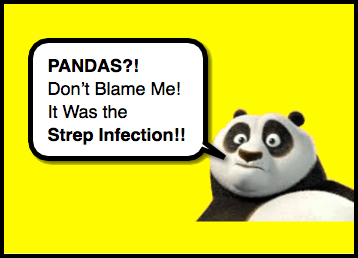PANDAS

PANDAS: Background
- PANDAS = Pediatric Autoimmune Neuropsychiatric Disorders Associated with Streptococcal infections
- Relatively new condition that was first described in 1998. [Swedo, 1998]
- Association with Strep Infections is still debated, but condition recognized a homogenous group of children. [Williams, 2014]
- Some chose to view PANDAS as a subset of PANS (Pediatric Acute-onset Neuropsychiatric Syndrome).
- Essentially, the understanding of the condition is still in its infancy.
- Etiology:
- Exact pathogenesis of PANDAS is not yet clarified.
- Possibly related to molecular mimicry between GAS and CNS epitopes leading to post-infectious autoimmunity in susceptible kids. [Esposito, 2014]
PANDAS: Diagnostic Criteria
- MUST HAVE: [Swedo, 2015; Swedo, 1998]
- Presence of OCD and/or Tic Disorder
- Obsessional fears of contamination or harm to self/others
- Compulsions involving washing, checking, repeating, and counting
- Tic disorder – involuntary motor tics (ex, nose twitching, eye blinking, head jerking, vocal tics, coughing, throat clearing)
- Often also have neuropsychiatric symptoms:
- Ex, anxiety, emotional lability, ADHD, Oppositional-defiant disorder, behavior regressions
- Again, these develop acutely and may be what catches family’s attention.
- Prepubertal onset
- Mean age = 6 years.
- Also distinguishes it from typical OCD, which has later onset.
- Abrupt onset or Exacerbation of symptoms with an episodic course
- Key feature is the acute and rapid onset of symptoms!
- Typically, patient was healthy previously.
- Associated neurologic abnormalities
- Choreiform movements
- Urinary urgency/ frequency due to enuresis
- Sleep disorders (ex, parasomnias)
- Temporal association between symptoms and Group A Strep infection
- No defined time window, but typically within 6 weeks
- Debated feature, as GAS infection is common in children
- GAS leading to pharyngitis or skin infections (ex, perianal) have been implicated. [Toufexis, 2014]
- Presence of OCD and/or Tic Disorder
- CANNOT HAVE:
- Sydenham’s Chorea or Acute Rheumatic Fever
- Thyrotoxicosis
- Systemic Lupus Erythematosus
- Wilson’s Disease
- Acute Disseminated Encephalomyelitis
- Toxin exposure
PANDAS: Treatment
- Primary treatment is symptomatic. [Esposito, 2014]
- Cognitive behavioral therapy
- Methods and tools to recognize triggers for tics and means to counteract them.
- Stress is a common exacerbating cause.
- Family counseling
- Psychoeducation
- Cognitive behavioral therapy
- Antibiotics (Penicillin)
- Mixed results about utility of antibiotic therapy. [Esposito, 2014]
- Some evidence that Penicillin is associated with improvement in tics.
- If the condition is related to autoimmune disorder, antibiotics being effective seems odd.
- Dopamine Antagonists
- Haloperidol and risperidone – used in severe cases of OCD.
- Tiapride (not available in the USA) – useful for motor tics.
- SSRIs may also be used for severe OCD.
- Immune-modulatory Therapy
- Plasma Apheresis or IVIG have been used, but should be reserved for severe cases.
- Plasma Apheresis may even be helpful after the acute presentation. [Latimer, 2015]
References
Swedo SE1, Seidlitz J, Kovacevic M, Latimer ME, Hommer R, Lougee L, Grant P. Clinical presentation of pediatric autoimmune neuropsychiatric disorders associated with streptococcal infections in research and community settings. J Child Adolesc Psychopharmacol. 2015 Feb;25(1):26-30. PMID: 25695941. [PubMed] [Read by QxMD]
Williams KA1, Swedo SE2. Post-infectious autoimmune disorders: Sydenham’s chorea, PANDAS and beyond. Brain Res. 2015 Aug 18;1617:144-54. PMID: 25301689. [PubMed] [Read by QxMD]
Latimer ME1, L’Etoile N, Seidlitz J, Swedo SE. Therapeutic plasma apheresis as a treatment for 35 severely ill children and adolescents with pediatric autoimmune neuropsychiatric disorders associated with streptococcal infections. J Child Adolesc Psychopharmacol. 2015 Feb;25(1):70-5. PMID: 25658452. [PubMed] [Read by QxMD]
Toufexis M, Deoleo C, Elia J, Murphy TK. A link between perianal strep and pediatric autoimmune neuropsychiatric disorder associated with streptococcal infection (PANDAS). J Neuropsychiatry Clin Neurosci. 2014 Apr 1;26(2):164-8. PMID: 24763762. [PubMed] [Read by QxMD]
Stagi S1, Rigante D2, Lepri G3, Bertini F3, Matucci-Cerinic M3, Falcini F3. Evaluation of autoimmune phenomena in patients with pediatric autoimmune neuropsychiatric disorders associated with streptococcal infections (PANDAS). Autoimmun Rev. 2014 Dec;13(12):1236-40. PMID: 25151976. [PubMed] [Read by QxMD]
Esposito S1, Bianchini S, Baggi E, Fattizzo M, Rigante D. Pediatric autoimmune neuropsychiatric disorders associated with streptococcal infections: an overview. Eur J Clin Microbiol Infect Dis. 2014 Dec;33(12):2105-9. PMID: 24953744. [PubMed] [Read by QxMD]
Wolf DS1, Singer HS. Pediatric movement disorders: an update. Curr Opin Neurol. 2008 Aug;21(4):491-6. PMID: 18607212. [PubMed] [Read by QxMD]
Swedo SE1, Leonard HL, Garvey M, Mittleman B, Allen AJ, Perlmutter S, Lougee L, Dow S, Zamkoff J, Dubbert BK. Pediatric autoimmune neuropsychiatric disorders associated with streptococcal infections: clinical description of the first 50 cases. Am J Psychiatry. 1998 Feb;155(2):264-71. PMID: 9464208. [PubMed] [Read by QxMD]

